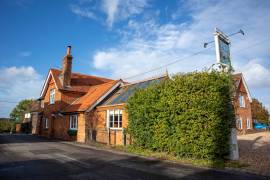Putting the taste to the test
How many of you list more than one New Zealand Sauvignon Blanc? Not many, I bet. I ask because there's quite a variation between the styles. Sauvignon Blanc from Hawkes Bay is a different animal from, say, Sauvignon grown in Marlborough.
And as New Zealand Sauvignon Blanc is featured on practically every pub list, it pays to think about the flavours coming out of the bottle: do you want cut grass and gooseberries, or do you want more tropical fruit flavours? Both, hopefully.
Would you believe there's even an annual conference to discuss this very issue? The Sauvignon Blanc Forum was held in Auckland in August last year to chat about the challenges and opportunities facing New Zealand's most sought-after grape variety. And it is, you know latest figures declare that Sauvignon Blanc hogs 42% of all New Zealand's wine production, followed by Chardonnay with 22% and Pinot Noir with 12%.
For good reason at last year's International Wine and Spirit Competition, New Zealand took all the golds in the Sauvignon Blanc category (double the number of golds of any other Sauvignon Blanc producing country), as well as claiming the Sauvignon Blanc Trophy for Villa Maria Cellar Selection Marlborough Sauvignon Blanc 2003. And it scooped the best International Sauvignon Blanc over £10 Trophy at the first ever Decanter World Wine Awards (St Clair Wairau Reserve 2003).
But enough trumpet blowing. You get the message: the world likes New Zealand Sauvignon Blanc, though we like it best the UK is the country's main export destination, accounting for 44% of all exports (more than 30 million litres).
But what do we really know about it? Most of you will be familiar with Marlborough Sauvignon Blanc the biggest wine-producing region on the north bit of the South Island, home to wine giant Montana, which first put the grape on the map.
And I'll never forget my first glass of it attention-grabbingly pungent, with its racy asparagus and gooseberry fruit. I was hooked.
Now I'm intrigued. New Zealand Wine Growers held a tasting in town recently to show off the diversity of styles, something the University of Auckland will be working on over the next few years.
The research boffins may be asking: what is the impact of terroir on the variety? How do viticultural practices affect flavour? How will different yeasts enhance specific flavour components during fermentation? But all I'm asking, as I swirl away, is why does Central Otago Sauvignon taste different to Hawkes Bay Sauvignon? And that question goes to Matt Thomson, Kiwi wine consultant extraordinaire, and the host of the event, held, suitably, at Kiwi Mecca, Peter Gordon's Providores in London's Marylebone High Street.
"Otago is the closest to a continental climate we have. Clay soils, cool nights, hot afternoons, and a shorter growing season," he explains, nose stuck into Mount Difficulty's 2004 Sauvignon Blanc, which is showing loitering tropical fruits, and a classy texture thanks to a smidgen of barrel fermen-tation, helping it to pair brilliantly with Gordon's roast halibut and smoky piquillo pepper relish.
The Hawkes Bay Sauvignon, on the other hand, from Morton Estate using Colefield Vineyard fruit is more of your citrussy kick, though coincidentally also fermented in oak (a growing trend "it makes the wine last longer in the bottle and gives it some weight," says Thomson). It set off Gordon's crab and tofu fritter with wasabi flavoured tobiko (flying fish eggs) a treat. "That's down to your free-draining gravely soils thanks to deposits made on the river terraces more than 30,000 years ago," explains Thomson.
My favourite SB of the tasting, though, is Mudhouse from Marlborough, Sauvignon's New Zealand powerhouse. Created by Thomson (he gets around, that boy), the wine is packed with elderflower and white currants, doing more than justice to the crispy deep-fried organic salmon nori roll with sweet soy. "It's very windy in Marlborough, which is a great advantage it dries out the grapes, so they ripen without rot. But there are many different soil types within Marlborough, which also affects the flavour. Will there be sub-regions here in years to come? Without a doubt," Thomson predicts. So hands up all those who thought all New Zealand Sauvignon Blanc tasted pretty much the same?
For stockist details contact New Zealand Winegrowers on 0207 973 8079.













